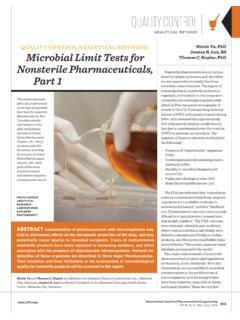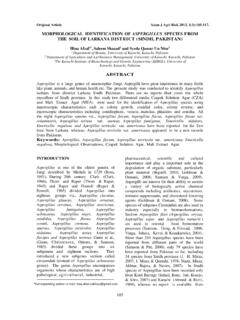Transcription of 61 MICROBIOLOGICAL EXAMINATION OF NONSTERILE
1 56 55 Biological Indicators Resistance Performance Tests / MICROBIOLOGICAL TestsUSP 35 Viable Spore Count. D-value determination methods for pa-per carrier biological indicators may be used to calculate the 61 MICROBIOLOGICALD value for nonpaper carriers. Incubation conditions for themicroorganisms that may be used for nonpaper biologicalEXAMINATION OF NONSTERILE indicators are described in the Total Viable Spore :MICROBIALFor Biological Indicators for Moist Heat, Dry Heat, and Gase-ous Modes of Sterilization, Liquid Spore Suspensions, theENUMERATION TESTS method of recovery following sterilization exposure condi-tions are those methods described in the Total Viable SporeCount section for liquid suspensions, and when a dry heatD-value determination is made from B. atrophaeus suspen-sions, the same recovery procedures as described under Bio-INTRODUCTION logical Indicator for Steam Sterilization, Paper Carrier tests described hereafter will allow quantitative enu-Where C.
2 Sporogenes is used as a biological indicator,meration of mesophilic bacteria and fungi that may growmethods for preparation, inoculation, and recovery methodsunder aerobic media must be adapted to accommodate the use ofThe tests are designed primarily to determine whether athis anaerobic or preparation complies with an established speci-fication for MICROBIOLOGICAL quality. When used for such pur-poses, follow the instructions given below, including theCalculationnumber of samples to be taken, and interpret the results asstated determination of D values of biological indicators canThe methods are not applicable to products containingbe performed using the Limited Spearman-Karber, Survivalviable microorganisms as active Method or Stumbo-Murphy-Cochran , 7, 8 Alternative MICROBIOLOGICAL procedures, including auto-It is preferable to use the same method as that defined bymated methods, may be used.
3 Provided that their equiva-the biological indicator manufacturer to determine D to the Pharmacopeial method has been use of a different method can result in differences thatare more an artifact of the method than a variation in theperformance of the biological PROCEDURESC arry out the determination under conditions designed toSurvival Time and Kill Timeavoid extrinsic microbial contamination of the product to beexamined. The precautions taken to avoid contaminationTake two groups, each consisting of 10 specimens of themust be such that they do not affect any microorganismsrelevant biological indicator, in their original, individual con-that are to be revealed in the Place the specimens of a group in suitable specimenIf the product to be examined has antimicrobial activity,holders that permit each specimen to be exposed to thethis is, insofar as possible, removed or neutralized. If inac-sterilizing conditions at a specific location in the BIER tivators are used for this purpose, their efficacy and of toxicity for microorganisms must beExpose the specimens for the required survival time, chamber, and remove the holder(s) containing the 10If surface-active substances are used for sample prepara-specimens.
4 Repeat the above procedure immediately, ortion, their absence of toxicity for microorganisms and theirpreheat if a substantial interval has elapsed, so as to subjectcompatibility with any inactivators used must bethe second holder(s) containing 10 specimens similarly first conditions, but for the required kill Survival time and kill time for all monographed biolog-ical indicators is described in the official monograph underENUMERATION METHODSthe heading for the Membrane Filtration method or one of the Plate-6 Pflug, Syllabus for an Introductory Course in the Microbiology and Engineer-ing of Sterilization Processes, 4th ed. St. Paul, MN: Environmental SterilizationCount Methods, as directed. The Most-Probable-NumberServices, 1980.(MPN) Method is generally the least accurate method for7 Pflug, , and Smith. The Use of Biological Indicators for Monitoringmicrobial counts; however, for certain product groups withWet-Heat Sterilization Processes, in Sterilization of Medical Products, ed.
5 Low bioburden, it may be the most appropriateGaughran and K. Kereluk. New Brunswick, NJ: Johnson and Johnson, 1977,193 , , and Pflug. The Spearman-Karber Method of AnalyzingThe choice of a method is based on factors such as theQuantal Assay Microbial Destruction Data, in Microbiology and Engineeringnature of the product and the required limit of microorgan-Sterilization Processes, ed. Pflug. St. Paul, MN: Environmental SterilizationServices, The method chosen must allow testing of a sufficientsample size to judge compliance with the specification. Thesuitability of the chosen method must be PROMOTION TEST, SUITABILITYOF THE COUNTING METHOD AND NEGATIVECONTROLSG eneral ConsiderationsThe ability of the test to detect microorganisms in thepresence of product to be tested must be from December 1, 2012 Copyright (c) 2012 The United States Pharmacopeial Convention. All rights from by aptuit on Sat Dec 15 08:25:06 EST 2012 USP 35 MICROBIOLOGICAL Tests / 61 MICROBIOLOGICAL Examination57 Suitability must be confirmed if a change in testing per-niques (seed-lot systems) are used so that the viable micro-formance or a change in the product that may affect theorganisms used for inoculation are not more than fiveoutcome of the test, is removed from the original master seed-lot.
6 Groweach of the bacterial and fungal test strains separately asdescribed in Table of Test StrainsUse standardized stable suspensions of test strains or pre-pare as stated below. Seed-lot culture maintenance tech-Table 1. Preparation and Use of Test MicroorganismsSuitability of Counting Method inGrowth Promotionthe Presence of ProductPreparation of TestTotal AerobicTotal Yeasts andTotal AerobicTotal Yeasts andMicroorganismStrainMicrobial CountMolds CountMicrobial CountMolds CountStaphylococcus aureusSoybean Casein DigestSoybean CaseinSoybean Caseinsuch as ATCC 6538, agar or Soybean CaseinDigest agar andDigest agar /MPNNCIMB 9518, CIP ,Digest BrothSoybean CaseinSoybean Caseinor NBRC 1327630 35 Digest BrothDigest Broth18 24 hours 100 cfu 100 cfu30 35 30 35 3 days 3 daysPseudomonas aeruginosaSoybean Casein DigestSoybean CaseinSoybean Caseinsuch as ATCC 9027, agar or Soybean CaseinDigest agar andDigest agar /MPNNCIMB 8626, CIPD igest BrothSoybean CaseinSoybean.
7 Or NBRC 1327530 35 Digest BrothDigest Broth18 24 hours 100 cfu 100 cfu30 35 30 35 3 days 3 daysBacillus subtilis such asSoybean Casein DigestSoybean CaseinSoybean CaseinATCC 6633, NCIMBAgar or Soybean CaseinDigest agar andDigest agar /MPN8054, CIP , orDigest BrothSoybean CaseinSoybean CaseinNBRC 313430 35 Digest BrothDigest Broth18 24 hours 100 cfu 100 cfu30 35 30 35 3 days 3 daysCandida albicans such asSabouraud dextrose AgarSoybean CaseinSabouraudSoybean CaseinSabouraudATCC 10231, NCPFor Sabouraud DextroseDigest AgarDextrose AgarDigest AgarDextrose Agar3179, IP , or NBRCB roth 100 cfu 100 cfu 100 cfu 100 cfu159420 25 30 35 20 25 30 35 20 25 2 3 days 5 days 5 days 5 days 5 daysMPN: not applica-bleAspergillus brasiliensis suchSabouraud dextrose AgarSoybean CaseinSabouraudSoybean CaseinSabouraudas ATCC 16404, IMIor potato dextrose AgarDigest AgarDextrose AgarDigest AgarDextrose Agar149007, IP , or20 25 5 7 days, or 100 cfu 100 cfu 100 cfu 100 cfuNBRC 9455until good sporulation is30 35 20 25 30 35 20 25 achieved 5 days 5 days 5 days 5 daysMPN: not applica-bleUse Buffered Sodium Chloride Peptone Solution pH orGrowth Promotion of the MediaPhosphate Buffer Solution pH to make test suspensions; tosuspend A.
8 Brasiliensis spores, of polysorbate 80 mayTest each batch of ready-prepared medium and eachbe added to the buffer. Use the suspensions within 2 hours,batch of medium prepared either from dehydrated mediumor within 24 hours if stored between 2 and 8 . As an alter-or from the ingredients to preparing and then diluting a fresh suspension ofInoculate portions/plates of Soybean Casein Digest Brothvegetative cells of A. brasiliensis or B. subtilis, a stable sporeand Soybean Casein Digest agar with a small number (notsuspension is prepared and then an appropriate volume ofmore than 100 cfu) of the microorganisms indicated in Ta-the spore suspension is used for test inoculation. The stableble 1, using a separate portion/plate of medium for suspension may be maintained at 2 to 8 for a vali-Inoculate plates of Sabouraud dextrose agar with a smalldated period of (not more than 100 cfu) of the microorganisms in-dicated in Table 1, using a separate plate of medium foreach.
9 Incubate according to the conditions described in Ta-Negative Controlble solid media, growth obtained must not differ by aTo verify testing conditions, a negative control is per-factor greater than 2 from the calculated value for a stan-formed using the chosen diluent in place of the test prepa-dardized inoculum. For a freshly prepared inoculum, growthration. There must be no growth of microorganisms. A neg-of the microorganisms comparable to that previously ob-ative control is also performed when testing the products astained with a previously tested and approved batch of me-described under Testing of Products. A failed negative controldium occurs. Liquid media are suitable if clearly visiblerequires an of the microorganisms comparable to that previ-Official from December 1, 2012 Copyright (c) 2012 The United States Pharmacopeial Convention. All rights from by aptuit on Sat Dec 15 08:25:06 EST 201258 61 MICROBIOLOGICAL EXAMINATION / MICROBIOLOGICAL TestsUSP 35ously obtained with a previously tested and approved batchgrowth by the sample cannot otherwise be avoided, theof medium of the microbial suspension may be added after neu-tralization, dilution, or of the Counting Method in theNEUTRALIZATION/REMOVAL OF ANTIMICROBIAL ACTIVITYP resence of ProductThe number of microorganisms recovered from the pre-pared sample diluted as described in Inoculation and DilutionPREPARATION OF THE SAMPLEand incubated following the procedure described in Recov-ery of Microorganisms in the Presence of Product, is comparedThe method for sample preparation depends on the phys-to the number of microorganisms recovered from the con-ical characteristics of the product to be tested.
10 If none oftrol procedures described below can be demonstrated to beIf growth is inhibited (reduction by a factor greater thansatisfactory, a suitable alternative procedure must be2), then modify the procedure for the particular test to ensure the validity of the results. Modification ofthe procedure may include, for example,Water-Soluble Products Dissolve or dilute (usually a 1(1)An increase in the volume of the diluent or culturein 10 dilution is prepared) the product to be examined inmedium;Buffered Sodium Chloride Peptone Solution pH , Phosphate(2)Incorporation of a specific or general neutralizingBuffer Solution pH , or Soybean Casein Digest Broth. If nec-agents into the diluent;essary, adjust to a pH of 6 to 8. Further dilutions, where(3)Membrane filtration; ornecessary, are prepared with the same diluent.(4)A combination of the above Products Insoluble in Water Suspend theNeutralizing Agents Neutralizing agents may be usedproduct to be examined (usually a 1 in 10 dilution is pre-to neutralize the activity of antimicrobial agents (see Tablepared) in Buffered Sodium Chloride Peptone Solution pH ,2).








